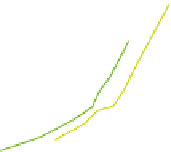Biomedical Engineering Reference
In-Depth Information
200
P/G
=
0
P/G
=
0.1
P/G
=
0.3
P/G
=
0.5
P/G
=
0.7
P/G
=
1
150
100
50
0
30
40
50
60
c
gel
(wt%)
70
80
90
100
Onset of melting temperature determined by differential scanning calorimetry (DSC) of gelatin
Figure 7.18
films containing various amounts of glycerol. The ratio P/G is the mass of plasticizer (glycerol) to
the mass of gelatin. Reprinted from Coppola et al.(
2008
) with permission of John Wiley & Sons.
agreement with the previous description of the gels. However, when the gelatin concen-
tration exceeds 50 wt%, T
m
increases sharply, e.g. reaching 180°C at c
gelatin
= 98 wt% (only
the bound water is left) for non-plasticized
films (P/G= 0). These very high melting
temperatures are related to the formation of bundles of triple helices, which aggregate
when the
films start to dry and the overall volume decreases (Pezron et al.,
1991
).
The melting temperatures for
films containing glycerol increase with the ratio P/G for a
given gelatin composition, as do the glass transition temperatures. Interpretation of the
phase diagram of plasticized
films highlights the role of hydrogen bonds between water
or glycerol and the protein residues. The
films are characterized by three states of
aggregation according to their concentration, temperature and plasticizer content: bun-
dles of triple helices, randomly oriented triple helices and random coils, which can be in
either a glassy or a rubbery state (Coppola et al.,
2008
).
7.3
Agarose
Agarose is a linear polysaccharide which can be extracted by treating agarophyte red algae
with alkali. It consists mainly of repeated sequences of the two residues
β
(1
3)-linked
→
d-galactose and
L-galactose residues (
Figure 7.19
). Agarose
is the purest material from the usual extracted commercial product agar-agar (or simply
'
α
(1
4)-linked 3,6-anhydro-
α
→
-
cant amount of the sulphated form, sometimes referred to as agarose sulphate, and some-
times agaropectin. Almost all the world
agar
'
). This product, like the carrageenan series described in
Chapter 5
, contains a signifi-
is production of agar is concentrated around Japan,
and the article by Matsuhashi (
1990
) is an interesting survey of both history and applications.
Agarose itself has therefore to be separated from a mixture of crude agar-agar which
also includes agarose sulphate, but this can be achieved following alkali treatment of the
original algae extract, eventually leaving pure agarose. This is assumed to be chemically
and electrically neutral, although it still contains some
'
'
rogue residues
'
of the sulphated






















































Search WWH ::

Custom Search